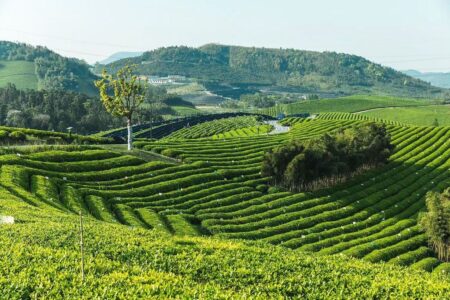Costa Rica strives to remain at the top of global coffee map

Farmers learn how to replant coffee. Image: ICAFE
Costa Rica’s coffee industry has been dealing with a multitude of factors that have negatively affected production, and while these challenges are not going away anytime soon, looking ahead, there is reason to be optimistic. By Shem Oirere
Costa Rica, one of Central America’s largest Arabica coffee growing countries, has maintained a top-tier coffee-nation status over the years, a position that could well be under siege from diverse emerging trends such as an aging coffee-growing population, recurring coffee diseases, changing coffee pricing dynamics and a muted economic performance exacerbated by the outbreak of the Covid-19 pandemic.
The former Spanish colony, whose coffee roots date back to the 1700s, has recently posted a decline in production by at least 7 per cent during the 2021/2022 marketing year to 1,275,000 60-kg bags, said to be “one of the lowest coffee-producing levels on record and the lowest in 50 years.”
This fall in output has several facets to it including fragile global coffee prices, shrinking coffee plantation acreage and growing unpredictability of the coffee picking labour market particularly because of political and economic upheavals in neighbouring Nicaragua, the biggest supplier of coffee-picking manpower for Costa Rica’s coffee farms.
Nevertheless, the latest industry reviews, including a May 2022 coffee annual report by the United States Department of Agriculture (USDA), predict a more than 7 per cent increase in Costa Rica’s coffee production for the 2022/2023 marketing year to 1,365,000 60-kg bags “as early rains arrived in sufficient volumes to support robust flowering in key growing areas.”
The increase in coffee output could also be boosted by the higher prices noted in the early days of the 2022/2023 coffee growing season, “signaling a strong return to on-farm investments in fertilisation and management practices.”
When the Covid-19 pandemic started to spread globally in the first and second quarter of 2020, the International Coffee Organization (ICO) composite indicator price recorded a decline of 4.1 per cent to an average of $1.0445 USD per pound, particularly in May, reaching a high of $1.0729 on 11 May, and a low of $0.9868 on 29 May. Although the fall in price was partly attributed to uncertainties triggered by the pandemic, the trend was also to do with the larger than expected output from Brazil’s 2020/21 crop.
Actually, by December 2021, the ICO had reported coffee prices reaching “a new multi-year high as the monthly average of the ICO composite indicator price broke through the 200 US cents/lb mark, averaging 203.06 US cents/lb.” This increase was equivalent to 4 per cent compared to 195.17 US cents/lb for the preceding month.
“The price levels during coffee year 2021/22 so far mark a return to the higher levels experienced in 2011,” ICO noted.
In May 2022, ICO reported a rebound of the Composite Indicator Price (I-CIP) of over 200 US cents/lb, the first time since February, hence gaining 4.5 per cent from May to June 2022, averaging 202.46 US cents/lb for June.

Export prices for Costa Rican coffee spiked in CY 2021/2022. Image: Starbucks
To cushion coffee farmers from the vagaries of fluctuating coffee prices, the Costa Rican government has recently developed “infrastructure needed to obtain higher prices for smaller lots of better quality coffee” according to USDA.
Moreover, achieving good prices for smaller lots of coffee has been made possible because of growing popularity of the practice of product differentiation that allows smallholder coffee producers “to capture higher sales prices.”
Anticipating export growth
This surge in global coffee prices could also coincide with an anticipated growth in Costa Rican coffee exports for the 2022/2023 marketing year. The USDA predicts the country’s coffee exports to reach 1,160,000 60-kg bags “the highest level since 2015/2016 as production volume rebounds and high quality Costa Rica coffee remains in demand globally.”
Costa Rica, whose coffee exports has its roots in the mid-1800s when pioneer industry players such as English captain William Le Lacheur Lyon sent hundreds of bags of Costa Rican coffee to Europe, particularly Britain, reported a 25 per cent increase in export price for the coffee sold during the 2021/2022 through April 2022 period to an average of USD $328.9 per bag.
However, the USDA said the price increase may not translate to a boom for Costa Rican coffee producers due to “lower production levels” during the period.
Export price for Costa Rica’s coffee spiked 1.56 per cent and 24.1 per cent from $261.30 to $265.40 and $328.90 between 2019/2020 to 2020/2021 respectively. The driving factors are those that have sustained Costa Rican coffee at the top of global coffee market chart such as high-quality coffee, deployment of environmentally friendly production practices, high level of coffee traceability and transparency, and equity in sharing coffee earnings among players along Costa Rica’s coffee industry value chain.

Young coffee trees growing in Costa Rica. Image: Vanessa L Facenda
Elsewhere, smallholder coffee producers, who are about 45,000 of the 70,000 registered Costa Rican coffee producers, have received sustainability labels such as Fairtrade through their primary cooperatives, translating into higher prices associated with coffee produced by farmers who promote environmental, social and economic sustainability, as well as shade-grown and organic coffee according to ICAFE, the non-profit organisation that oversees and promotes the quality and sustainability of Costa Rican coffee, and which is funded by a 1.5 per cent tax on every pound of coffee exported from Costa Rica.
Fairtrade certification, has in most instances, boosted the bargaining power of the cooperatives in areas such as Santa Elena, Buenavista, Sarapiquí, Tilarán, Montes de Oro, Pilangosta, Llano Bonito, and Coopeldos leading to better coffee prices.
The higher export prices, combining with Costa Rica’s anticipated economic turnaround with growth projections of 3.2 per cent in 2022 and 2.6 per cent in 2023, is likely to spur increased domestic coffee consumption, especially in the 2022/2023 coffee season.
“Domestic demand will strengthen moderately in 2022 and exports will benefit from the reactivation of the tourism sector in the last quarter of 2022 and 2023,” says an economy snapshot on Costa Rica by the Organisation for Economic Co-operation and Development (OECD).
Costa Rica, whose coffee the government says in one report “is prized as some of the world’s best and is shipped everywhere from Austin to Amsterdam,” is likely to post an increase in its domestic coffee consumption projected to reach 420,000 60-kg bags for the 2022/2023 period. The increase is 5 per cent higher than the 400,000 60-kg bags for 2021/2022 season.
Previously, the consumption declined to 196,000 60-kg bags in the 2020/2021 coffee year, excluding imports, the lowest since 1994/1995 with ICAFE, which in 1985 succeeded the 1977-established Costa Rica Coffee Research Centre (CICAFE), attributing the drop to “sharp economic contraction in 2020 and 2021 due to the Covid-19 pandemic.”
The economic contraction was exacerbated by a global recession that was triggered by the pandemic, which damaged the Costa Rican tourism industry, with expectation the recovery would “be protracted, with the economy estimated to grow by 2.6 per cent in 2021, following a strong contraction in 2020” according to the International Monetary Fund (IMF). Furthermore, the USDA report says during the pandemic “restaurants, cafeterias, hotels and other coffee-serving outlets were closed during different periods of time or were required to operate under limited conditions.”
Challenging but optimistic
Moving into the future, Costa Rica’s coffee sector is expected to focus on finding solutions to some glaring challenges that could constrain growth in production, leading to instability in export and domestic consumption levels.
A case in point are the recurring fungal diseases such as coffee leaf rust and anthracnose in coffee-producing provinces such the San José, Alajuela, Puntarenas, Heredia, and Cartago, despite the perfect coffee growing conditions there such as plentiful volcanic soils that are not only acidic but also extremely fertile and have altitudes between 1200m and 1700m.

Shaded coffee plants growing in Costa Rica. Image: Vanessa L Facenda
These conditions have been seen to encourage cooler climates that have in recent times given way to “higher than normal precipitation levels” linked to the damage of the young coffee fruit. “Continued high moisture levels and high temperatures supported the development of fungal diseases,” states the USDA report with the worst affected region being the mountainous Los Santos.
“Although there are more coffee rust-tolerant varieties available, adoption has been slow given the substantial costs involved in renovating plantations, especially among small producers who can least afford to forego income until the new plants begin producing,” the report explains.
Furthermore, there is has been a notable decline in the number of coffee producers due to what USDA says is “long periods of low coffee prices, aging farmers, and high land prices near urban areas.” The report further states that most of the remaining coffee growers – 86 per cent in 2020/2021 marketing year – are small farmers, who produce the equivalent of fewer than 100 bags of coffee each year.
In a related trend, the acreage under plantation coffee production has been shrinking as growers fall further behind the ‘ideal plantation renovation plan’. According to the USDA, the plan requires a plantation coffee farmer to replant 5 per cent of their plantation area annually, hence completely renovating the entire plantation in 20 years.
However, recent strong coffee prices decrease the incentive for farmers to replant, which, the USDA notes, takes area out of production for three years, and farmers have exhibited reluctance to plant new varieties that may have higher rust-resistance or higher yields until they can verify the results on someone else’s land nearby. “These factors, combined with access to credit and available genetic material have contributed to the steady aging of Costa Rica’s plantations, which has already contributed to persistently lower yields,” the report adds.
But the future of Costa Rica’s coffees, with the most classic being mild and softly acidic, looks as bright and promising as ever with some growers said to be currently experimenting with new flavours that are brighter and fruitier according to ICAFE.
The commitments of the Costa Rican government to promote transparency along the coffee industry’s value chain, coupled with state-supported coffee producer incentives, and growing interest in this market by local and international brands are likely to shape the Central America country’s coffee market supply-side and demand trends in the long term.
- Shem Oirere is a freelance business journalist based in Nairobi, Kenya. He has spent more than 25 years covering various sectors of Africa’s economy including the region’s agribusiness. He holds BA in International Relations and Diplomacy from the University of South Africa and earned a higher degree in journalism from the London School of Journalism and is also a member of the Association of Business Executives (ABE).



